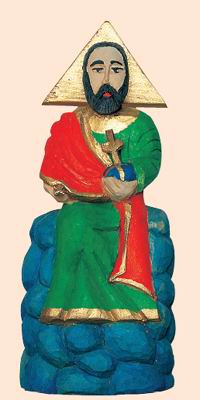Juraj Zajonc
Martin Mešša (1949) learned about wood from his grandfather, who was a carpenter and joiner. Since his childhood he has met with the work of professional sculptors – his father was director of the Gallery of Fine Arts in Prešov. He became acquainted with the development and varied range of forms of traditional culture and folk art by studying ethnography. As a publicist at Slovak TV and later as an employee of the Šariš Museum in Bardejov, he came across demonstrations of traditional culture and amateur creators. Objects he got to know from books he was later able to recognize in the Slovak National Museum in Martin and ÚĽUV.
The result of connecting ideas from domestic as well as specialist environments together with his individual creative abilities is the carving work of Mešša. The central element of this world is the body of a human, man and a woman, musician or a shepherd, Madonna and Pantokrator, an angel or sacred man. He is inspired in his secular works by the traditional carving of anonymous creators, often utilitarian objects (e.g. carving on a mug or tools decorated by carving). He is also interested in the figures on wooden grave stones, the decoration of shepherds’ staffs, folk musical instruments, or the details on folk costumes. His interest in themes from the traditional way of life and folk art comes from his ethnographical education. However, he also pays attention to elements of art in building.
The religious line of Mešša’s work is a series of New Testament pictures transferred to carving on a sculpture. Where he uses samples of other carving work in his production, he does not copy them but rather uses some of their elements and details. However, he does also make copies, but then he always acknowledges the original source. Mešša also searches for printed samples interesting to him, which he then modifies and simplifies.
The largest number of works in Mešša’s creations are sculptures, of which there are more than 100. The characteristic format for his creation are carved pistons. The shape of the piston, without the rod can be found in several of his reliefs. In total, Mešša is the author of more than 70 reliefs of various sizes.
Mešša regards himself as an art-nouveau carver in relation to much of his work. His motivation is naturally traditional folk wood carving, and therefore he considers himself mainly as a folk carver and representative of art folklorism.
